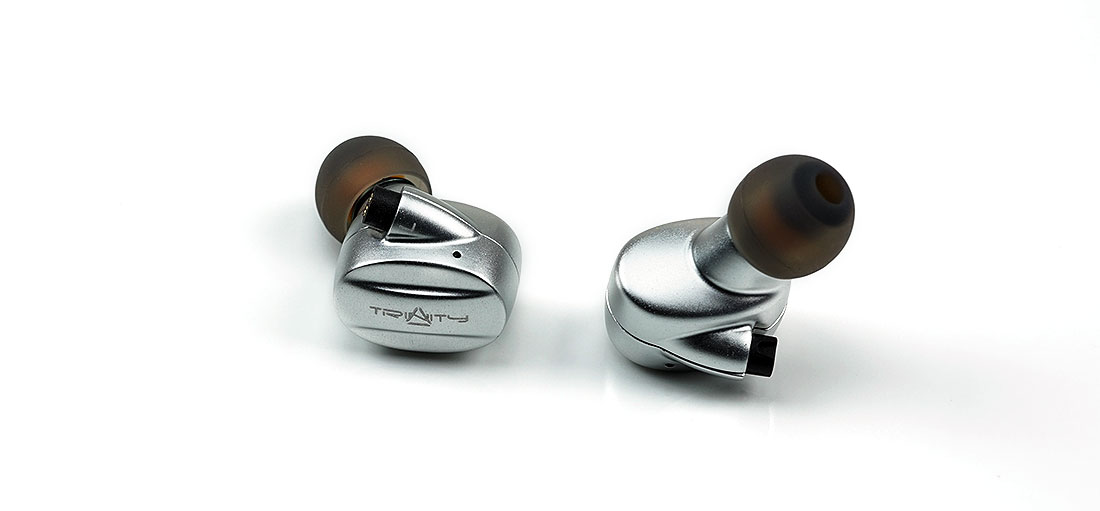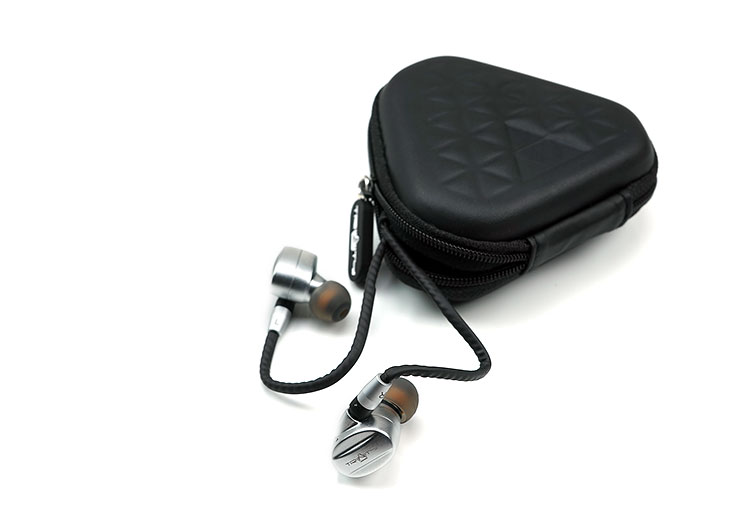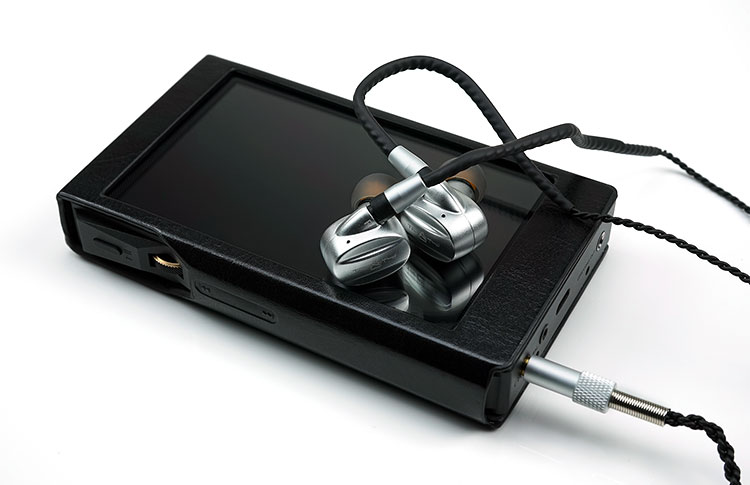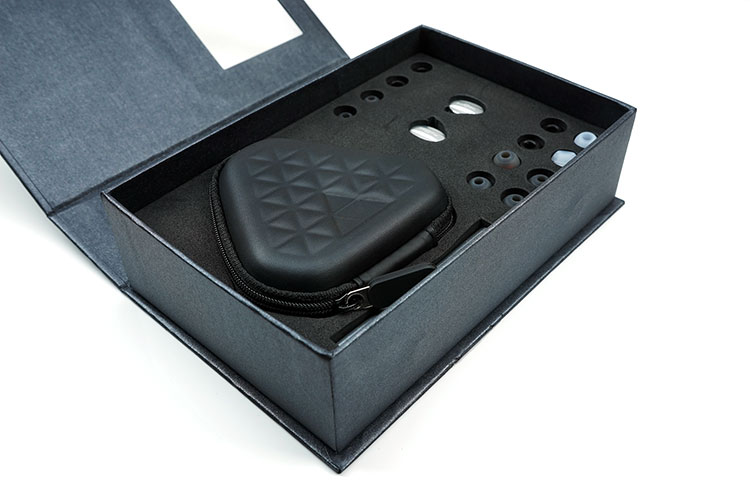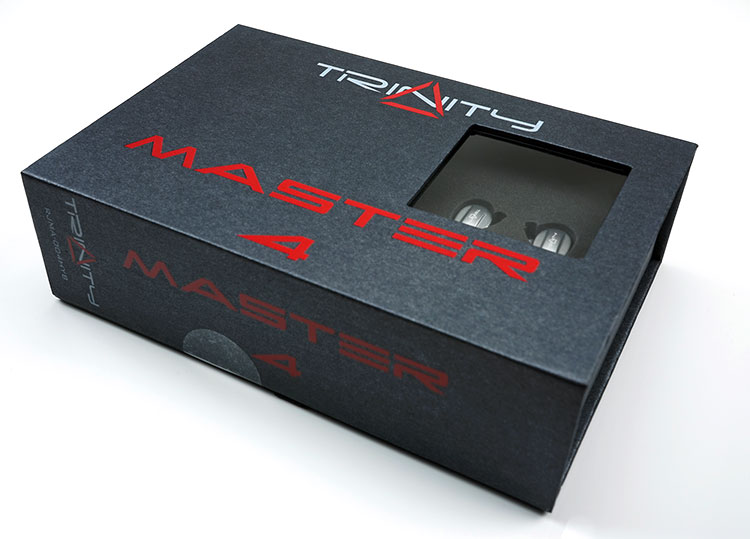Sound Impressions
Tonality & Presentation
With several filters to choose from, there is really no single fixed tonal presentation with the Master 4. However, there are some core aspects of the Master 4 tonality that carry through with each filter.
At its heart this is a generally musical sounding signature with a slightly elevated midbass presence with good snap though with a bit of sub-bass roll off that is compensated somewhat with the silver ‘enhanced bass’ filter. There is some warmth in the low end but generally speaking, the mids and treble come across closer to neutral than warm and in the case of the damper filters actually quite smooth and easy going.
Mids are slightly dipped though can be adjusted with the purple filter and vocals have a good presence, smooth with decent texture and lacking in sibilance. Instrumental separation is just ok but there are occasions, with the damper filters mainly combined with heavy rock, that the Master 4 lacked a little bit of openness leading to a relatively congested sound. It does suit a slightly more sparse mid-range mix more common with modern pop and dance.
Treble performance varies with from smooth and laid back to forward and reasonably sparkly but overall you could not describe the Master 4 as a treble head dream with a slight lack of air though it remains reasonably articulate through most variations.
Gunmetal Filter (Smooth)
Tonality
The gunmetal filter (dampened) comes out of the box stock and fitted already to the Master 4. Trinity describes this as a smooth and balanced filter and they are not too far off the mark with that description.
Bass
My note on the official description is the bass performance being somewhat tuned more to the musical aside. There is an emphasis on a mid bass elevation rather than out and out sub-bass power giving it a warm low end with decent depth and pushing it more towards a u-shaped signature. That being said I rarely find the bass performance of the Master 4 with the gunmetal filter to be overpowering or sloppy. Rather it carries some decent weight, full sounding and does convey some decent impact when pushed but overall it remains coherent with the rest of the range.
Mids
Mids are neutral though not overly prominent with decent balance throughout. Instrumental timbre is warm and inviting rather than clinical or overly accurate. The emphasis here is on a flowing easy on the ear delivery so notes have a slightly softer edge and sibilance is at a minimum. Lower mids on the Master 4 though do not sound overly thinned out or positioned well behind the vocals.
Vocals are more on an even keel with instrumental positioning, perhaps marginally boosted for a bit more clarity and presence. You will get a smooth vocal delivery, by the way, particularly Light-Lyric Baritones, breathy vocals or anything with a light or smoky and warm tone will excel with the Master 4.
Treble
Treble performance is slightly laid back and forgiving in nature and thankfully avoiding any unnecessary boosting in the lower treble adding to that smooth flowing tonal presentation. The BA performance in the upper registers is pacey and articulate enough and there is some good detail actually. I do like the Master 4 gunmetal tuning on the treble quite a lot; it may be easy going but it never sounds shelved down or lacking in air with a tiny emphasis just in its tail in the final octave around 12k to just to add some sparkle.
Purple Filter (Treble)
Tonality
The purple filter is described by Trinity as offering a reduced bass signature with a focus on upper mids and treble and for my money that is pretty much spot on. It would not be my preferred filter out of the four lacking in a little body and low-end extension but may prove more suitable for those looking for a bit more emphasis on the Master 4’s BA speed and clarity. Artists such as Lindsey Stirling work best on the Purple Filter.
Bass
The gunmetal mid-bass elevation is flattened with a more linear if a somewhat leaner low-end response from the Master 4 as a response. It still has presence, it is not anemic in that respect but it is much less noticeable with the purple filter.
Mids
Vocals play a more prominent role now with the purple filter, particularly higher pitched female vocals. You do loose a bit of richness from the gunmetal filter so instruments have a slightly thinner sounding timbre, slightly less inviting but with the same level of detail. If you prefer a more mid-focused signature and a cleaner presentation than the purple filter will do that.
Treble
Treble is also more forward sounding though lacks a little in body but nothing harsh or overly boosted. In short, it doesn’t sound peaky and has a bit more sparkle than the smoother gunmetal signature.
Purple With Damper
The damper purple filter takes a little bit of edge off the forward sounding upper mid and treble focus and adds a touch more body both to the low end and mids. If I had to choose between both I would pick the purple damper filter over the non-damper version just for that smoother upper mid to lower treble transition it offers, it just sounds more natural than without the dampening.

Silver Filter (Enhanced Bass)
Bass
Trinity Audio describe the silver filter as offering a V-shape signature while retaining plenty of musical detail and in our testing, we did find the bass to be fuller sounding with more sub-bass presence and good mid-bass impact.
This is easily their most musical filter with regards to low-end performance. This is the kind of filter you need for modern RnB and EDM/House with better low-end power and a healthy dose of upper treble sparkle.
Mids
It still doesn’t overcooked mind you with a nice dip in the upper bass lower mids keeping a good sense of clarity and whilst the vocal is more recessed than say the gunmetal or purple filter I actually didn’t find the detail to be lacking in comparison to the other filter signatures.
I wouldn’t pair it with classic metal or rock. The vocal presence does not have enough body or texture to sound convincing with say Rob Halford’s powerful range. It does sit rather more comfortably with Beyonce or Lana Del Ray’s reverb-heavy vocal performances. If you want a better focus on vocals I would switch to the Gold or Gunmetal filters.
Treble
Treble was more on par with the gunmetal filter but not as forward or as clear sounding as the Purple or Purple damper filter which is just fine for my tastes. It is not the airiest v-shape I have heard and certainly doesn’t have the reach of say the IT03 but it is relatively articulate and clear sounding.
Silver With Damper
The damper offered the same V-shaped signature as the stock silver filter only this time with a slightly softer treble attack. It has the same level of articulation but comes off just a little bit more laid back.
If this wasn’t a v-shaped signature in purpose I would be quite fine with the treble tonality as the transition is smooth and seems more even in its response. It also comes across as a little bit more natural its presentation.
However, this filter is designed to be a v-shaped presentation and as such, I prefer the non-damper silver edition just to bring in a cleaner sound with a bit more sparkle up top. If you are going EDM then a strong top and bottom are preferable.
Gold Filter (Perfect Balance)
Tonality
Described as a perfect balance between gunmetal and the treble enhanced purple filter this should be your go-to filter for a cleaner presentation and a good balance between the texture and body of the gunmetal and the sparkle and clarity of the purple filter. I could easily work on this or the gunmetal filter depending on my source.
Bass
Whilst not quite the same boosted level of the gunmetal filter the bass performance of the gold filter is snappy, tight and full sounding with some nice PRaT overall especially with modern RnB and EDM. I wouldn’t see it as a replacement for the enhance bass silver filter for low-end power but it’s otherwise coherent if slightly more bias to being musical sounding than linear in response. I do find this push-pull driver business to perform best when the bass is let loose a bit more so it can show off a bit more.
Mids
Mids are similar in performance to the gunmetal but with a slightly cleaner edge and sounding a bit more dynamic and open in its presentation. Instrumental timbre is not quite as warm, close to neutral in that respect though vocals retain a fairly smooth character and lacking in any sibilance.
Treble
Treble has an enhanced sparkle reminiscent of the purple filter with a bit more bite in the upper mid to lower treble response and a more prominent attack on percussion passages as well as a touch of hifi sparkle in the final octave. It is almost on par with the Purple filter in terms of top end performance though still contextually still a fairly smooth top end.
Gold With Damper
The damper takes the edge of a little in the snap and returns the gold filter back to a slightly smoother but cleaner version of the gunmetal filter.
It is not quite as clear sounding as the undamped version and just a touch more congested in the mids but if you are after the gold’s generally vibrant response but with a softer leading note then the gold damper filter is a good option. I find it perfect with “phat” beats and smoky soul type vocal pitching.
Matchability
SmartPhones
The Master 4 is rated at 16 ohms and 108dB and as such you shouldn’t find too much of a problem supplying enough voltage for volume. On a decent smartphone, such as the ZTE Axon 7 volume sat comfortably around 7-8/10 and dynamics were actually not bad so credit to the push-pull dual DD for not going flat with low current or weaker amps.
DAPs
On higher quality dedicated DAPs, the Master 4 does put out a better performance. Imaging tightens up with a more vivid midrange. Across the board you will not find the Master 4 susceptible to noise and background hiss, it is not a super-efficient design in that respect. This includes tests for noise on the FiiO X5iii, Cayin i5, Sony A35 and AK240.
i5 & X5iii
The Cayin i5 and the X5iii combined with the gold filter were particularly solid pairings with EDM and trance, sounding spacious, clean and with a good vocal performance. Both have a tighter mid-bass snap and better dynamics than the weaker Axon 7.
Out of the two, the X5iii edged it slightly for me for its superior midrange detail and better vocal texture but if you want a more aggressive low end then the Cayin i5 is the better fit with the Master 4. The Master 4 does seem to enjoy a much more dynamic sounding and musical source and sounds at its best when the push-pull dual DD’s are being maximized with bass-centric source tracks.
AK240
If you happen to be pairing with a more neutral cleaner DAP with a linear low end such as the AK240 then I might suggest switching over to the gunmetal filter to thicken it up a touch or even the silver filter if you want a heavier bass bias.
Sony A35
This is an excellent budget pairing actually and one I highly recommend you demo before deciding on a DAP to pair with if the cash is tight. It doesn’t offer the very best in detail but it does offer a very smooth and musical presentation with the Master 4.
In particular, it matches well with the purple filter (with damper) and the gold filter (without damper). The purple filter is bass lean with an emphasis on the top end but with the smoothed out treble performance of the purple damper filter you get a nice mid-centric sound with good top end articulation that pairs quite well with easy listening tracks, acoustics, and jazz. The gold filter works with pretty much any genre on the A35 offering good bass weight, a clean but smooth midrange though with a more laid back treble than the purple filter.
Portable Amps
Cost Benefit
The Master 4 does benefit a little from portable amping but I would hesitate to go all out on this simply because $300 portable amps do not make fiscal sense matching to the Master 4 unless you already have one. Better to invest in a good portable DAP such as the X5iii or even the A35.
For instance, the ALO Audio RX portable IEM amp is just stellar matched with the Master 4. This pairing just puts the Master 4 dynamics and staging on a whole new level over smartphones and weaker DAPs but it is double the price of the Master 4.
Budget Amping Options
Better to look at amps such as the FiiO A5 or if you can source one since they are now discontinued, the E12a. The A5 will bring a darker bass heavier sound than the RX and perhaps a little too much power than required but it does bring a healthier level of dynamic performance and superior staging to the Master 4, whereas the E12a is really perfect in terms of power and tonal balance for the Master 4. Either will work just fine and the cost is much more attractive $120 or so.
Select Comparisons
RHA T10
$199.95
Specs
The T10 is a triple filter single dynamic driver IEM rated at 16 ohms and 100dB and is known for its fairly bass-biased signature that leaves all but one of its filters, the treble filter, capable of producing what I would term as a balanced filter. The injected molded casing of the T10 (and the T20) is rock solid though and a class above the Master 4 in that respect though slightly heavier. The QC on the filter threads on the T10 is also just a bit higher spec.
Tonality
Tonally the T10 is a much darker and heavier hitting experience than the Master 4 with a great emphasis on its low to upper bass performance and a slight 2-3k boost for vocal performance. This is even with the treble filter on the T10 compared to the silver filter with damper.
The Master 4, by comparison, is a more balanced warm to neutral experience with a more open midrange though both have a fairly relaxed treble unless you throw on the purple filter on the Master 4. There you get a fairly considerable gap in terms of upper mids to treble performance. The T10 will take the points for rumble and power but the Master 4 has the edge in mids and treble.
RHA T20
$239.95
Specs
The T120, much like the T10 is also a metal injection molded triple filter single dynamic driver IEM. It is rated at 16 ohms and a slightly less sensitive 90dB and also includes 3 filters, bass, reference, and treble. It differs from the T10 with its dual coil driver technology as well as sporting a slightly more referenced sound than the bassy T10. You can get decent voltage to drive it on smartphones much like the Trinity Master 4 but performs optimally with better current and stronger amps.
Tonality
The T20 has a more balanced tonal presentation than the T10 with the reference filter and has a warm to neutral tonality with superior resolution and dynamics than the Master 4. Staging quality has better depth and top end extension also with the T20. Vocals on the T20 are that bit further forward than the Master 4 even with the more balanced gunmetal and gold filters.
Moving to the purple filter will give a more prominent vocal and top end performance that is more aggressive and forward sounding on the Master 4 but you lose that low-end power that the T20 is capable of producing.
Granted the T20 is more expensive than the Master 4 and in this case, it does have the superior tonal performance in most respects. I would take the T20 over the Master 4 but I may opt for the Master 4 over the T10. The filters on the Master 4 are more flexible sounding than the T10 variants.
Echobox Audio Finder X1
$149
Specs
The Finder X1 is a single DD IEM, again with a triple filter combo rated at 22 ohms and 96dB and rocking a reasonably v-shaped PEEK German diaphragm driver. The 3 filters are in much the same vein in terms of bass, reference and treble though the QC on them is a bit lower than the RHA versions and on the same level as the Master 4.
Tonality
Tonally the Finder X1 is more v-shaped cooler sound than the more mildly u-shaped presentation of the Master 4. It has more sub-bass presence but less of a mid-bass hump. It also dips a bit more into the midrange, sounding thinner, before coming out with a more forward and sparkling, but sometimes peaky, treble performance. Both have similar levels of detail though the more forward nature of the Finer X1 will be perceived as being more articulate and extended.
Compared to the Master 4’s more balanced and smoother treble delivery you could argue that the X1 has the better depth and extension but at the cost of sounding that thinner more brittle sound. Using the X1’s bass filter or silver filter is the best option to fatten up the sound and smooth down the treble performance but personally, I am on the gold or gunmetal filter with the Master 4 for its smoother and more balanced signature for most things. If I want ‘out and out’ low-end rumble and top end extension though I would consider the X1.
Our Verdict
It is so rare to see a quad driver, a hybrid no less, at this price point. It is also very rare to see no less than 7 filter options, 3 cables and a host of other accessories all stuffed into said IEM at said price. That makes it the most valued packed IEM I have come across sub $200.
Of course, I have had this discussion about filters before, most recently in the Finder X1 review, and that is the question of choice in terms of how you want your IEM to sound. This choice negates the first reaction we normally have – does it sound good or bad and avoids outright rejection. If anything by not putting all your eggs in one basket you stand a chance of the buyer saying they prefer that filter over this filter rather than saying they do not like the sound of the IEM in the first place.
It is a good marketing ploy is nothing else but unlike the ones packed with just 3 filters and settling on one I actually found with the Master 4 a use for 3 of the filters in my general day and daily use so I consider the Master 4 filter selection to be much more constructive and imaginative than previously reviewed product lines that use a filter system.
Things I would like to change up? I think the QC of the filters could do with a bit of work, some of them are rough on the threaded screw fittings and the memory hooks are a bit too thick and stiff as well as the carrying case being a bit too small. I would also like to have seen a 3rd tube for the filters rather than a plastic bag for the final set.
Other than that I think you getting good money’s worth and a very nice selection of different tonal tweaks on a fairly musical and fun sounding IEM.
Technical Specifications
- Cable Length: 1.4m
- Driver Size: 7mm (DD)
- Frequency Response: 20Hz – 20kHz
- Impedance: 16Ω
- Sensitivity: 108dB




